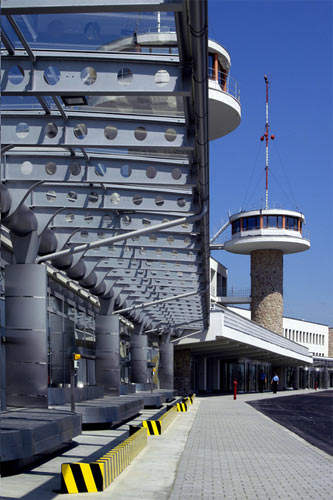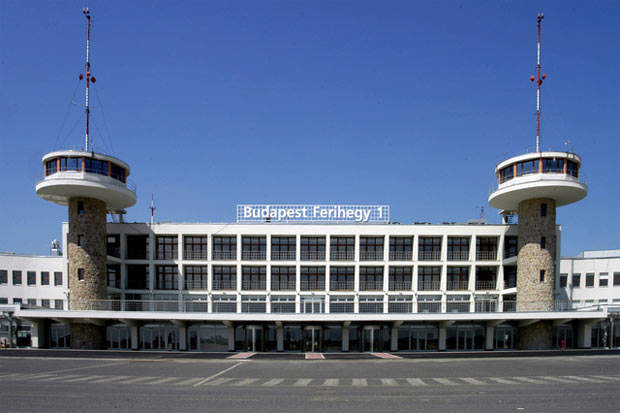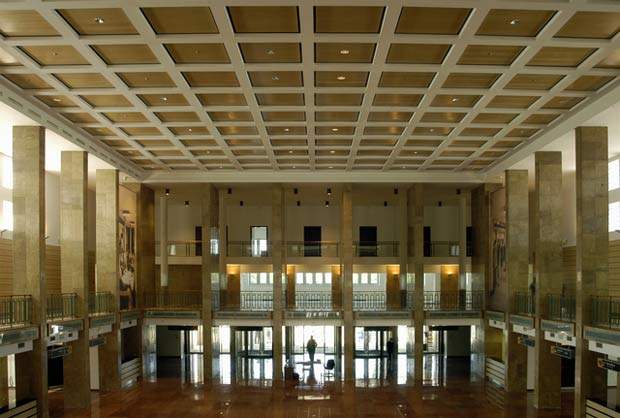Budapest Ferihegy International Airport serves the capital city Budapest and the surrounding areas. The airport is one of four international airports in Hungary but is by far the largest.
The international connections from the airport are primarily within Europe, but there are also some to Asia, the Middle East, and North America. Located 10 miles (16km) south-east of the centre of Budapest, the airport has excellent transport links
via the four-lane M0 Budapest ring road expressway and is accessible by articulated bus and car.
A municipal rail link to the airport’s three terminals was completed in 2007. The airport is big enough to accept the largest passenger aircraft such as the Boeing 747 and also large cargo transporters such as the Antonov An-124; it has not yet been decided if the airport facilities will be upgraded to accept the Airbus A380.
In December 2005, BAA plc secured a 75% stake in Ferihegy Airport for a consideration of HUF464.5bn (Hungarian Forint) ($2.1bn). BAA was awarded a lease to operate the airport for the next 75 years. In October 2006 BAA were negotiating with a consortium led by Hochtief Airport GmbH to sell its stake for a consideration of £1.309bn. The sale, which was completed in November 2006 gave the Hochtief consortium the same 75-year rights over the airport that BAA had established.
For the 12 months to April 2006, total passenger traffic reached 8.24 million a 17.8% rise over the same period in 2005. But with a further rise to 8.6 million passengers in 2007 the airport saw a further 4% increase in passenger numbers over 2006.
The increase is being driven largely by the number of passengers travelling by the airport’s five established low-cost airlines, which reached, for the year ending April 2006, more than 2.29 million low-cost passengers – a 2.4% rise.
Airport terminals
The airport has three main terminals (1, 2A, 2B) and also a smaller one for general aviation (GAT) flights.
Terminal 1 was demolished in 2004 to make way for a new Terminal 1 that serves all the low-cost airlines now flying into Hungary. The terminal was recently reconstructed and opened up to the public in September 2005.
Terminal 2A was originally built exclusively for MALÉV Hungarian Airlines, but it now serves MALÉV’s airline partners as well. The terminal is modern and well-designed and replaced the original terminal, constructed in 1985.
Terminal 2B is treated as a separate terminal although it is connected to terminal 2A and it serves all of the international flights and airlines not served by terminal 2A.
The general aviation terminal located on the left side of terminal 1 serves private planes, and also has an apron parking area for them. The airport has two runways of approximately 3,000m and 3,700m in length.
Expansion
The reconstruction of the 24,000m² terminal 1 began with the demolition of the old terminal in October 2004. The deadline for the construction of the new building was tight with only eight months being allowed (3,000 construction workers were involved).
By July 2005 the reconstruction of terminal 1 had been accomplished and its technical opening was carried out, although the terminal was not opened to passengers until September 2005. The oldest terminal had now been turned into the most modern,
capable of handling over 2.5 million passengers a year.
The construction contractor, Magyar Építő Részvénytársaság, reconstructed the building using a generic steel frame structure and was also responsible for the building service
engineering and electric systems including connection of the public utility conduits and the air-conditioning.
Ervin Jaklics was the chief designer of the new terminal and he worked very closely with a team from the Hungarian architecture firm ÁMRK.
Other contractors involved in the project included: Kipszer Tervezo és Fovállalkozó Zrt. (Kipszer planning and main contractor corp.), Állami Muemlék-helyreállítási és Restaurálási Központ (state monument renovation and restoration centre), Lakóterv Kft., UVATERV Rt, HÉROSZ Építoipari Zrt. (HÉROSZ building corp.) and Resonator Vállalkozási és Kereskedelmi Kft. (Resonator enterprise and commerce Ltd), VIV Zrt.
Also, as part of the terminal reconstruction, a parking area of 300 parking lots was built for terminal 1 to serve the hire car, drop off zone and also the newly designated taxi service for the airport (replacing the notoriously corrupt taxi
service).
The reconstruction of terminal 1 is only the first phase of the long-term development of the airport, which is seeing an above-average increase in passenger traffic year on year.
The airport established a three-year incentive scheme in 2008 to attract more airlines to the airport. In addition there is a €261m (HUF656bn) future modernisation program underway called BUD Future, which will see amongst many other projects a new linking concourse between terminals 2A and 2B called BUD Skycourt. Additional projects will establish a new cargo city, construct an Airport City including, a four-star hotel with 250 rooms, and will overall increase the airport’s airside capacity.
Air cargo base
Prior to BAA’s takeover of the airport a new large air cargo facility was about to be built at the airport.
The construction was delayed by a political scandal about public spending that led to contract cancellations (because inflated prices were to be paid for the land at Ecser and Vecses).
More importantly, BAA was committed to expanding the airport operation and when asked about the new cargo base they said that the current land owned by the airport was sufficient. The previous management purchased ACD Kft, the owner of the land
suitable for the cargo base, in February 2005.
According to the multi-phase contract worth a total of HUF4.7bn, BA Rt (the airport management company) would have been the majority owner of the company that owned the 20ha (200,000m²) land adjoining the airport, and would have built the base on
the land having all the building permits required for the development.
The move was required because there was not enough space for the new cargo base and the logistical centre within the boundaries of the airport. The contract was then declared null and void at the insistence of the then finance minister, although BA’s management had authorisation from the State Holding Company ÁPV Rt to conclude the agreement.
BUD Future
In December 2007 the BUD Future project was launched. This is a modernisation program which is due to go on until 2011 and that will see a new terminal building to link 2A and 2B.
Because of the space required for the project in the first phase, a 3,200m² container city is being constructed from 201 containers as a temporary airport handling unit for airport staff. The two-storey H-shaped container city will provide office space, meeting rooms and lockers for about 300-350 employees. The facility will be needed for approximately three or four years and will also have a 7,300m² parking lot.
Rapid taxiway
In April 2006 the new taxiway, named Julietta, was opened. The new facility expanded the airport’s capacity and also minimises the noise impact on surrounding communities.
The new taxiway has reduce the occupancy time of Runway 1 and its capacity will increase as a result of the development, thereby reducing the need to use Runway 2 for arrivals from the direction of Budapest.
Construction began in September 2005 with the pavement itself completed by the end of October, and lighting and control technology installed by the first quarter of 2006. There are now three rapid exit taxiways at Ferihegy airport: Zulu, Yankee and J4
(Julietta).
For the construction, 10,000m² of earth was moved and 12,000m² of filling material was used. The 30,000m² pavement is made of special asphalt designed to bear the weight of the largest aircraft.
Terminal 2 apron expansion
In May 2008 Budapest Airport agreed a contract for the extension of the terminal 2 apron with the VHS Apron consortium led by Vegyépszer and including Hochtief Construction Magyarország Kft. and Swietelsky Kft.
In the first phase, 76,000m² of apron area will be built to provide stands for aircraft and increase the capacity of the airport. There are plans to construct a total of 170,000m² of apron by 2011. The total value of the contract is €16.8m (HUF4.2bn). The contractors have to demolish 18,000m² of asphalt and 3,100m² of concrete and move 100,000m³ of earth to build the apron area.
Security improvements
In May 2008 the airport invested €3.5m (HUF900m) in a new passenger security system across the airport that includes state-of-the-art X-ray machines, magnetic gates and various other passenger screening equipment.
The new equipment was tested and then deployed across all three terminals with three hand-baggage screening machines operating at terminal 1, five at terminal 2A and four at terminal 2B. The X-ray machines are the latest models of Smiths Heimann and work on the principal of computer tomography screening the contents of the baggage from two different angles. Because of new software the machines will also be able to detect explosives by relative atomic weight and density (no more false positives from chocolate).
A new security lane system serving the X-ray machines will be built at terminal 2 consisting of nine new, 13.5m-long channels. This new area will allow the airport to handle more passengers at the same time, and there will also be segregated cubicles fitted behind the security gates, so that passengers’ clothing can be searched quickly and discretely. In addition the airport operator has also expanded its security staff by 100.













